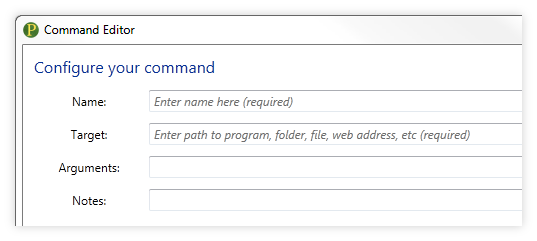What is a command?
The command is the heart of Promptu; it tells Promptu what you want to do.
Command configuration

Name (required)
The name of your command. You should give your commands meaningful names so you can easily identify them. Names can contain
namespaces.
If you want to give your command multiple names, separate each name with a comma.
firefox
folder.tmp
cmd,commandPrompt (aliased)
Target (required)
Whatever the target of this command is. You can optionally use Input Transformation Language (ITL) to make it dynamic. A target can be:
- A path to a file, folder, or program
- A web address
- Anything you can type in the Run box (
Start->Run)
@reboot@ (reboot your computer)@shutdown@ (shutdown your computer)@logoff@ (log yourself off)@lock@ (lock your computer)@standby@ (make your computer go into standby)@hibernate@ (hibernate your computer)@screensaver@ (start your screensaver)@multi@ (execute multiple commands specified in the arguments, see arguments section below for more information)
C:\resources\example.doc
C:\tmp\
\\computer\share\
http://PromptuLauncher.com/
cmd
mstsc
http://en.wikipedia.org/wiki/Special:Search?search=<!n!> (uses ITL to capture parameters from the prompt)
Arguments
Usage context: your command runs a program or uses @multi@.
The arguments to pass to the executed program or, if using @multi@, a list of command invocations separated by &.
You can use Input Transformation Language (ITL) to make it dynamic.
(Note: if you are using @multi@ and need the & within a command invocation expression, you must escape it with another & like this: &&)
Normal
-arg1 arg1value -arg2
-arg1 <!1!>
@multi@
command1 parameter1 <!2!> & myOtherCommand
command 012 "345" & command2 6789
command 012&&789 & command2
Notes
Any notes you want to include with the command for reference. Notes are shown with the command in the setup dialog and as the description of the command in info tooltips.

Working directory
If your command's target is a program, you can specify the directory (aka, folder) to make the working directory when the command is executed.
Helpful for programs that depend on having a certain working directory.
You can use Input Transformation Language (ITL) to make it dynamic.
Tip: You can use the Guess the working directory based on your command's target checkbox instead of copying the file's parent directory path.
Startup state
If your command's target is a program, you can specify whether you want the program to start in a normal, minimized, or maximized state.
Run as administrator
If your command's target is a program, you can specify whether you want the program to start elevated with administrator permissions.
Show parameter history
Only visible if parameters are specified using ITL.
Specify whether you want to show parameters supplied to the command in history. Overridden on an individual basis by the settings specified in Parameter information.

Parameter Information
Only visible if parameters are specified using ITL.
Specifies information about parameters.
Parameter(s)
A parameter or parameter range in the format:
startNumber
where startNumber is the 1 based index of the argument or n.
OR
startNumber - endNumber
where startNumber is the 1 based index of the first argument in the range and
endNumber is the 1 based index of the first argument in the range or n.
Description
A value that describes the parameter or parameter range.
Suggestion mode
Suggestion modes may be configured (if the selected mode allows configuration) by clicking the button to the right of the Suggestion mode column.
None: Do not provide any suggestions for the parameter, except history if "Show history" is checked. File system: Use Promptu's powerful directory navigation feature from within the parameter, with the option to specify a filter for the files shown.
You can separate multiple filters using the "|" character.
If you would like a filer to not show files that match it, place a "!" at its beginning.
You can use a "!" by itself to hide all files (and only show folders).
Use on a command that opens the command prompt in a specified folder.
Use on a command that copies certain files into a specified folder.
Value list: Select a value list you want suggested for the parameter.
Using a list of cities for a command that looks up the weather forecast for the specified city.
Function return value: Allow a function to generate a String[] or ValueList to use in suggesting for the parameter.
The configurable ITL expression indicates which function to use.
You may use ITL substitutions in the expression to capture the values of previous parameters.
Using a function that returns a list of all the currently running processes on the computer.
Using a function that connects to a database and returns a list of values.
Show history
Indicates whether to show history for the parameter or parameter range.
|








